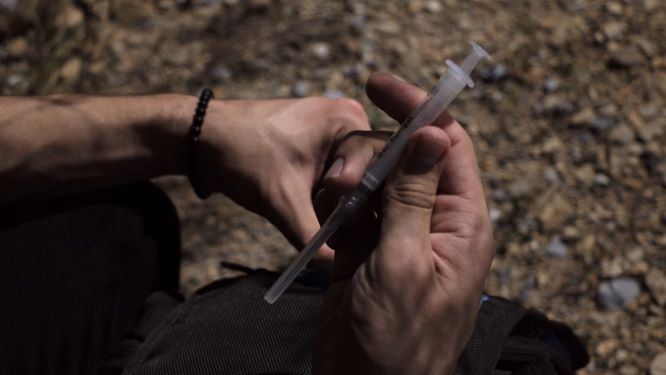Home Page
Case 1: Shortness of Breath
Case 2: Fever
Case 3
Introduction
Outcome
Deposition
Legal
Documentation
Medical Review
Now that we have seen the initial case, the review of the documentation, and the outcome, we will explore medical learning points from this case. I’ll emphasis a few points that are relevant, and highlight some good #FOAMed resources and studies for further reading.

- Mixing opioids with benzodiazepines is a high-risk situation.
One of the primary issues that many readers will notice while reviewing this case is the decision to give the patient a benzodiazepine so soon after a heroin overdose. From the description of the patient’s condition when EMS first found her, she likely had used a fatal dose of heroin. The only thing that prevented this were assisted respirations and naloxone. This patient still had a potentially lethal amount of heroin in her system that was simply masked by naloxone, when she was then given a dose of Ativan. The combination of opioids and benzodiazepines are synergistic in their effect on the respiratory system and can rapidly lead to apnea. This association is well-described in the literature (https://www.ncbi.nlm.nih.gov/pubmed/28292769). The combination is commonly used in Emergency Departments for procedural sedation. However, ED procedural sedation is not done with fatal doses of an opioid, as is present in this case. Neither the benzodiazepine alone nor the naloxone-masked opioid were enough to cause respiratory depression while in the ED, but once the naloxone wore off, the partially-metabolized opioid combined synergistically with the benzodiazepine and resulted in her unrecognized apnea. The combination of opioides and benzodiazepines can be safely prescribed in the ED, where continuous monitoring ensures safety. Unfortunately, in this case the patient was not being continuously monitored, she was instead undergoing 15-minute checks by staff at the detention center. It is unclear what happened during these checks, but they likely did not include a full set of vital signs. Giving benzodiazepines to someone already on massive doses of opioids is dangerous, especially if they are not going to be monitored in a hospital setting.
- Take the first step in helping patients overcome their addiction.
The jaded ER doctors among us will scoff at this point. They’ve seen the same patients again and again in the ED with the same drug problem. But we have a responsibility to help patients take the first step towards sobriety, even if it means repeatedly starting from the beginning. Opioid withdrawal is not life-threatening but is extremely unpleasant. This is in contrast to other substances, including alcohol, that can be life threatening when a patient is withdrawing. (http://www.emdocs.net/drug-withdrawal-pearls-pitfalls/). Options that are available for opioid withdrawal treatment include supportive care, giving small doses of opioides to partially relieve symptoms, clonidine, and buprenorphine. Supportive care includes treatment of symptoms such as nausea and dehydration. Clonidine has been shown to help relieve withdrawal symptoms and is usually started at 0.1mg PO every few hours. Another option is the use of buprenorphine (Suboxone). This medication functions as a partial mixed opioid agonist/antagonist. It is given as an IV dose or can be prescribed in the sublingual form. There is no PO tablet. There is evidence suggesting that starting buprenorphine treatment from the ED makes it more likely that patients will be able to complete the withdrawal process without relapsing. There are 2 primary barriers with using buprenorphine. The first is that starting this medication in the ED is only the first step in a multidisciplinary process that is not available from some EDs. The patient will need to follow-up with a provider who can continue prescribing this medication. Many individuals who suffer from opioid abuse do not have primary care doctors and are often uninsured, making access very difficult. Accessing comprehensive addiction treatment services is also very challenging in many parts of the US. The ED is not a panacea of addiction treatment; it functions best as a first link or gateway into addiction treatment. The second main barrier is that prescribing buprenorphine requires a special DEA waiver. Many EM physicians do not have the waiver, but it is obtainable.
Resources:
- Patients with capacity after receiving naloxone can safely refuse EMS transport.
Treatment begins with naloxone administration in the pre-hospital setting. While the patient in this case was transported to the hospital after being given naloxone, there is actually good evidence to suggest that transportation to the hospital may not even be necessary:
- An observational study from UCSD examined opioid overdose patients who were given naloxone by EMS and then signed out AMA. They have a policy that patients are allowed to refuse transport to the hospital if they are assessed to have capacity after naloxone. They searched medical examiner databases to find death records and compare them to the records of the 998 patients who signed out AMA. There were no identified deaths in this group within 12 hours of signing out AMA. (https://www.ncbi.nlm.nih.gov/pubmed/12896894?dopt=Abstract)
- A similar study was conducted using data from the San Antonio Fire Department. 552 patients were given naloxone and recovered to have capacity and refuse transport at the scene. Medical examiner records were reviewed and no deaths within 48 hours were identified, far beyond the timeline expected with opioid rebound. Several deaths were identified in this group but the shortest time frame was 4 days. (https://www.ncbi.nlm.nih.gov/pubmed/21612385)
- 2241 opioid overdose patients were treated and released on scene in Copenhagen, “if no residual signs of opioid intoxication are found after treatment”. They identified 14 patients who died within 48 hours of treatment, and 3 of them were found to be due to rebound opioid toxicity. This amounts to a 0.13% risk of death from rebound effect. (https://www.ncbi.nlm.nih.gov/pubmed/21745532)
- The Los Angeles Fire Department has a similar policy. Researchers reviewed patients who had an initial respiratory rate <12, received naloxone, and refused transport. 205 patients were identified, and results from the coroner only revealed one death within 24 hours. (https://www.ncbi.nlm.nih.gov/pubmed/27018626)
There are certainly some limitations from these studies. They are observational. Some patients may have died and not been included in the medical examiner records. It is unclear if any of these patients refused transport but had an opioid rebound that would have been fatal if they had not been rescued by a bystander or had a repeat EMS call. These studies suggest that transport from scene is probably not necessary if patients respond to naloxone and have capacity to refuse transport.
- Short observation in the ED is sufficient after opioid overdose.
Once a patient has been transported to the ED, how long do you need to watch them? There has been significant research examining the utility of observation after naloxone.
Most patients transported to the ED for opioid toxicity are ultimately discharged. Recommendations for observation in the ED range from 1-2 hours (https://wikem.org/wiki/Opioid_toxicity)to 4-6 hours (https://www.ncbi.nlm.nih.gov/pmc/articles/PMC3739053/).There are also studies that suggest one hour observation if the opioid was heroin (https://www.ncbi.nlm.nih.gov/pubmed/17067327). This is also highly dependent on the type of opioid used. Obviously, longer acting opioids need longer periods of observation. These include methadone and fentanyl patches. Further compounding the issue is the fact that we often have no way to independently confirm what the patient took. Patients who are apneic with miotic pupils after injecting themselves with a substance are often assumed to be on heroin. While this may be correct, it is more of a high-percentage guess than a statement of actual certitude. Patients may also be unaware of the exact composition of the illicit drug they have purchased; it may be a combination of various opioids or even include other substances. A patient telling their doctor that they are certain they took heroin is likely correct, but there are obvious problems if they are incorrect.
Even among patients who are admitted to the hospital, there is evidence that these patients rarely require any treatment at all. A study looking at 124 ED visits for opioid overdose found 12 admissions, and none of them had any recurrence of respiratory depression (https://www.ncbi.nlm.nih.gov/pubmed/1416327).
In this malpractice case, the patient was observed for 2 hours and 18 minutes from the time of naloxone administration to the time of discharge. The discharge vitals show HR 99, BP 100/66, RR 18, 93% on room air. The documentation describes her as wide awake, talking to police, walking with a steady gait when she left the ED. While the accuracy of this statement was later called into question, based on this description of her condition, discharge seems reasonable and within the standard of care. It is impossible to tell what would have happened if the patient had not been given Ativan, but the bad outcome makes us question whether she would have survived if it was not given.
